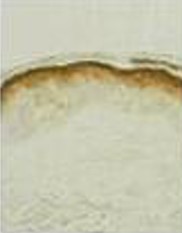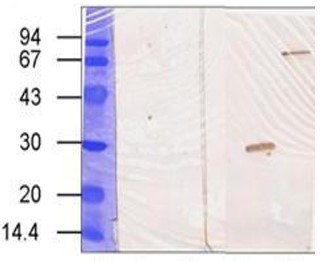Anti-Transglutaminase-3 (TG3) Antibody (90022)
Anti-Transglutaminase-3 (TG3) Antibody (90022)
Product No.: 90022
- -
- -
Clone C2D Target Transglutaminase-3 (TG3) Formats AvailableView All Product Type Monoclonal Alternate Names EC 2.3.2.13, Transglutaminase E, TG(E, TGE, TGase E, Transglutaminase-3, TGase-3 [Cleaved into: Protein-glutamine γ-glutamyltransferase E 50 kDa catalytic chain; Protein-glutamine γ-glutamyltransferase E 27 kDa non-catalytic chain] Isotype IgG1 Applications ICC , IHC , WB |
Data
- -
- -
Antibody DetailsProduct DetailsReactivity Species Human Host Species Mouse Immunogen Recombinant human TG3 (accession no. Q08188). Formulation Lyophilized, 0.1M Tris, 0.1M glycine, 2% sucrose, 1mg/ml. State of Matter Lyophilized Product Preparation Purified by Protein A affinity chromatography Storage and Handling This product is stable for at least one (1) year at -20°C to -70°C. Reconstituted product should be stored in appropriate aliquots to avoid repeated freeze-thaw cycles. Country of Origin USA Shipping Next Day 2-8°C Applications and Recommended Usage? Quality Tested by Leinco Immunoblotting: use at 1-5ug/mL. Bands of ~77kDa and ~30kDa are detected.
Immunocytochemistry: use at 2-10ug/mL. These are recommended concentrations. Enduser should determine optimal concentrations for their applications. Each investigator should determine their own optimal working dilution for specific applications. See directions on lot specific datasheets, as information may periodically change. DescriptionSpecificity Mouse Monoclonal Antibody specific to Transglutaminase-3 (TG3) Background Transglutaminase-3 (TG3), an epidermal- type enzyme, is responsible for formation of the epidermis. During keratinocyte differentiation, TG1 and TG3 appear to act cooperatively in the cross-linking of proteins, including involucrin, loricrin and small proline-rich proteins (SPRs). These reactions result in formation of the cornified envelope (CE), a specialized component consisting of covalent cross- links of proteins beneath the plasma membrane of terminally differentiated keratinocytes. Furthermore, TG3 in hair follicles is involved in cross-linking structural proteins such as trichohyalin and keratin intermediate to hardening the inner root sheath. During differentiation in these processes, a zymogen form of TG3 (77 kDa) is activated by limited proteolysis with cathepsins S and/or L. Antigen DetailsFunction Catalyzes the calcium-dependent formation of isopeptide cross-links between glutamine and lysine residues in various proteins, as well as the conjugation of polyamines to proteins. Involved in the formation of the cornified envelope (CE), a specialized component consisting of covalent cross-links of proteins beneath the plasma membrane of terminally differentiated keratinocytes. Catalyzes small proline-rich proteins (SPRR1 and SPRR2) and LOR cross-linking to form small interchain oligomers, which are further cross-linked by TGM1 onto the growing CE scaffold (By similarity). In hair follicles, involved in cross-linking structural proteins to hardening the inner root sheath. {ECO:0000250}. NCBI Gene Bank ID UniProt.org Research Area Enzymes References & CitationsTechnical Protocols |




